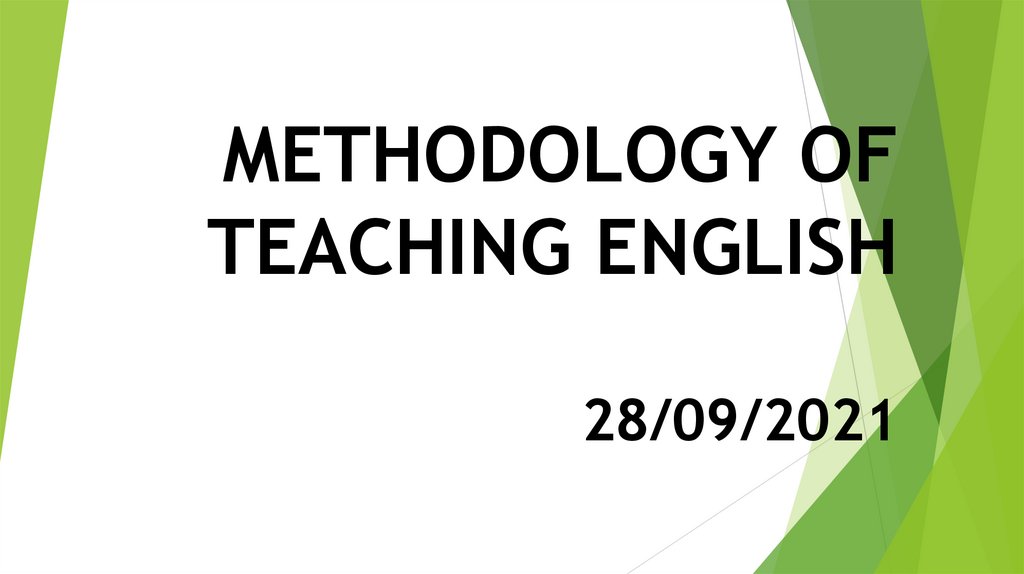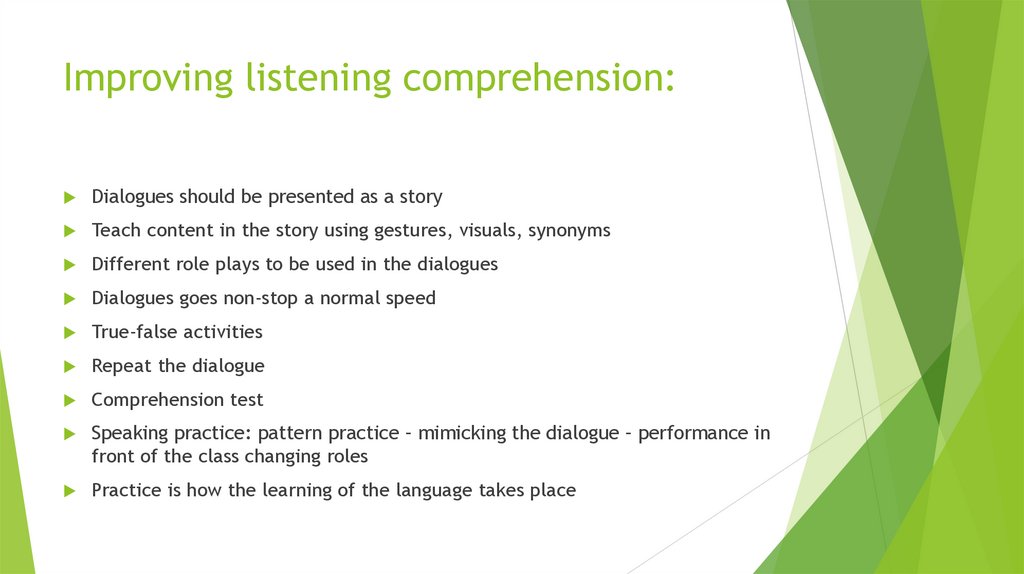Similar presentations:
Methodology of teaching english
1.
METHODOLOGY OFTEACHING ENGLISH
28/09/2021
2.
Components of methodologyLearning process/teaching process
Goals/aims
Contents
Principles
Methods/approaches
Teaching techniques
Means of teaching
Forms of teaching
3.
MethodsTraditional
language teaching
Communicative language teaching
Innovative language teaching
4.
The Direct Methodreaction against Grammar-translation Method (the end of the 19th century)
stresses direct thinking and discussion in foreign language
emphasizes the use real-world objects and actions to show what is being communicated
regarded as a tool for communication and something that is generated spontaneously
pre-requisites (industry, trade, colonial expansion, psychology)
5.
The Direct Method (Natural)The Direct Method is a system of instructing a foreign language using only that language and
without focus on the study of grammar
It is a method of teaching a foreign language through conversations, discussions, and
reading in the language itself, without the use of the pupils’ language, translation and
without the study of formal grammar
Direct because it was done without any resort to the mother tongue
Assumption: we learn a foreign language as we learn the mother tongue
6.
Characteristics:Teaching is entirely in the target language (native language is not
permitted)
Grammar rules are avoided
Strong focus on the sound pronunciation
Method attempts to form an intentional connection between
thought and expression and between experience and language
7.
Principles of the Direct MethodActive use of the language in the classroom
Instructions are conducted solely in the target language
Only everyday vocabulary and sentences were taught
Oral communication skills were built in graded progression
Organized around question-answer exchanges between teacher and students
Grammar rules were not explicitly taught but rather learned through intensive listening
and imitation, thus memorizing conjugations and rules is not prioritized, importance is on
speech
New teaching points are introduced orally
8.
Principles of the Direct MethodTranslating is perceived as unproductive practice (thus, theatrical
presentation, demonstration or pointing at objects are used to explain the
meaning of words)
Small, intensive class
Concrete vocabulary (tangible items) – demonstration, pictures
Abstract vocabulary - associations of ideas
Reading and writing are postponed until firm ground is secured in listening
and speaking
9.
Typical Direct Method lessonStarts with warm up activity (physically active to refresh students’ memories)
Introduction of new material (one term or phrase at the time), then
modelling how to use phrases
Working in pairs (guided work/independent practice)
10.
Typical techniques of the Direct MethodQuestions and answers activities (use of words and grammar rules in new sentences)
Reading aloud
Self-correction
Conversation activities
Fill-in-the-blank exercise
Dictation
Map drawing
Paragraph writing (using the model and teaching materials)
The ‘mim-mem’ technique
Songs
Memorizing
11.
Strengths/advantagesWeaknesses/shortcomings
Teacher and students are partners
in the process
More applicable in the classrooms of
small size
Large amount of learner-learner
interaction
Natural order in developing skills
Requires a lot of time to point out the
meaning of words, especially abstract
ones
Emphasis on speaking
Better pronunciation
Spelling errors due to focus on
speaking mostly
Learners learn the language, not
about the language
Not suitable for all learning styles
Lively classroom procedure motivation
Learning is contextualized
Teaching vocabulary through realia
brings authenticity into the
classroom
12.
The Audio-Lingual Method (Army Method)Emphasizes listening and speaking before reading and writing
Dialogues are the main means of presenting a language; drills are the main
tolls for learning
Assumption: certain traits of living things can be trained by reinforcement
Language is a system of sounds and for social communication; writing is a
secondary derivative system for recording of spoken language
Language is a form of behaviour to be learnt through the formation of correct
speech habits
13.
The Audio-Lingual MethodEmphasis on the acquisition of structures and patterns in common everyday dialogue
Drills are used to teach structural patterns
Set phrases are memorized with a focus on intonation
Grammatical explanations are kept to a minimum
Vocabulary is taught in context
Audio-visual aids are used
Focus is on pronunciation
Correct responses are positively reinforced immediately
Each skill is treated and taught separately (reading and writing are not neglected but
focus is on listening and speaking)
Dialogue is the main feature
Language lab was introduced
14.
Techniques of ALMDialogues are used to teach useful vocabulary and common communication
structures (students must memorize every line from the dialogue; learning
occurs by mimicking the instructor, through repetition over time, starting
with whole class, then smaller groups, finally, the individuals)
Combination of listening and speaking makes sense; listening is the key to
effective speaking
Listening comprehension is still the most neglected aspect of language
learning
15.
Improving listening comprehension:Dialogues should be presented as a story
Teach content in the story using gestures, visuals, synonyms
Different role plays to be used in the dialogues
Dialogues goes non-stop a normal speed
True-false activities
Repeat the dialogue
Comprehension test
Speaking practice: pattern practice – mimicking the dialogue – performance in
front of the class changing roles
Practice is how the learning of the language takes place
16.
Strengths/advantagesVisuals are effective in vocabulary
learning
Weaknesses/shortcomings
Teacher-dominated method
Not all four skills are given equal
importance
Mechanical method (pattern practice,
drilling, memorization)
Easy to use in larger groups
17.
DM vs ALMBoth reject mother tongue
Combat deficiencies presented by GTM

















 english
english








